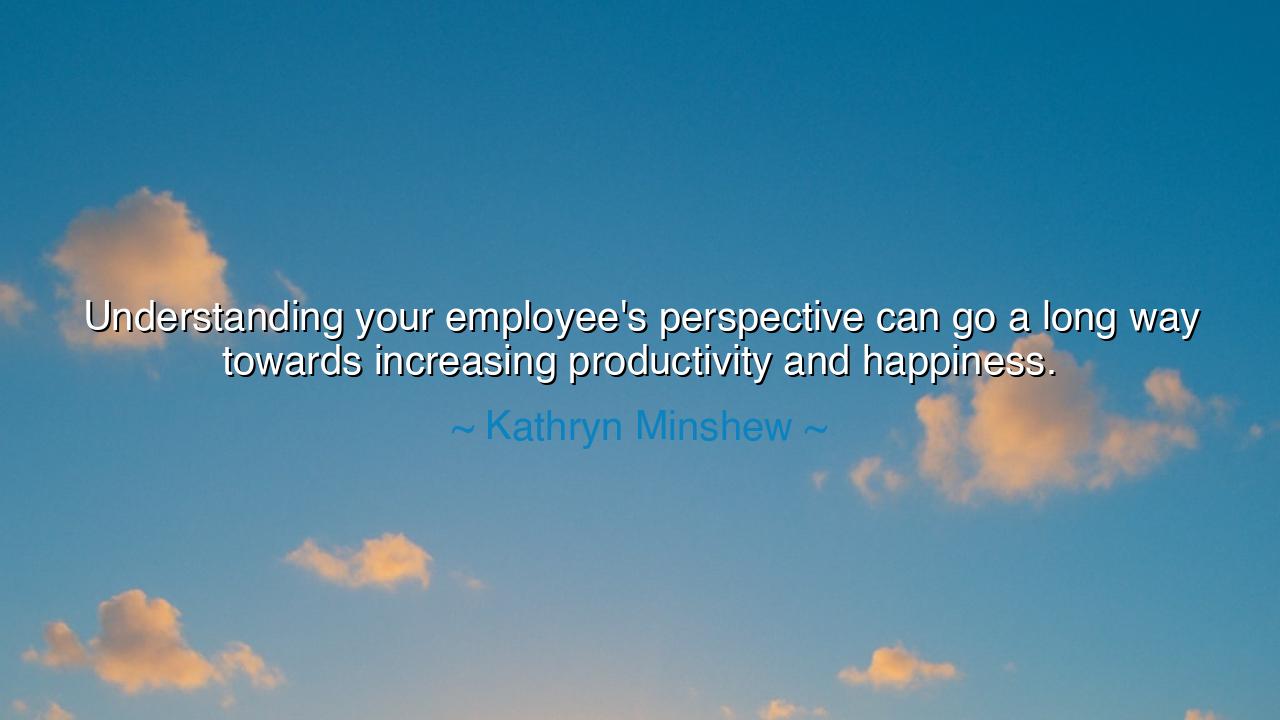
Understanding your employee's perspective can go a long way
Understanding your employee's perspective can go a long way towards increasing productivity and happiness.






“Understanding your employee’s perspective can go a long way towards increasing productivity and happiness.” — Kathryn Minshew
In this simple yet profound statement, Kathryn Minshew, the visionary founder of The Muse, speaks of a wisdom that is as ancient as leadership itself: the art of understanding. To lead others is not to command them from above, but to walk beside them, seeing through their eyes, feeling through their hearts. The one who rules by fear may gain obedience, but the one who rules through empathy gains loyalty, creativity, and joy. For when a leader seeks to truly understand the perspective of their people, they awaken the spirit of cooperation that no threat or bribe can ever achieve.
In the old kingdoms, many rulers mistook power for wisdom. They built walls of hierarchy and silenced the voices of those beneath them. Yet the wise kings and queens — those whose names endure in history — were the ones who listened. Solomon, famed for his wisdom, was not praised for his armies or wealth, but for his ability to see into the hearts of his people. When two women came before him with a child, both claiming to be its mother, he discerned truth not through law, but through understanding of human emotion. This was leadership born not from dominance, but from empathy — the sacred art of seeing the world as another soul perceives it.
To understand another’s perspective is to dismantle the walls that divide “leader” from “follower.” In the realm of work, it means recognizing that employees are not mere tools or numbers, but living beings with dreams, fears, and private battles. A person who feels unseen cannot create with passion, but one who feels understood will move mountains. The productivity and happiness Minshew speaks of are not external rewards; they are the natural fruits of trust. When people are valued for their humanity, their energy aligns with purpose, and the work of many hearts becomes one harmonious force.
Think of Abraham Lincoln, who, even in the furnace of civil war, made time to walk among his soldiers, to speak with them, to listen. He wrote letters to grieving mothers, visited the wounded, and welcomed criticism from those beneath him. This was not weakness — it was strength born of compassion. His leadership flowed from his ability to understand the struggles of others, to feel their pain and bear their hope. His army did not fight only for a cause; they fought for a man who saw them as more than soldiers. And through this understanding, Lincoln bound a broken nation together.
The wisdom of Kathryn Minshew’s words lies in their simplicity: productivity cannot be forced, but it can be inspired. Happiness cannot be demanded, but it can be nurtured. To do so, one must first listen — not only with the ears, but with the heart. Ask not only, “What can this person do for me?” but “What do they need to thrive?” Such questions turn workplaces into communities, and labor into purpose. It is through understanding that leadership transcends management and becomes mentorship, and that work transforms from obligation into fulfillment.
But understanding is not effortless. It demands patience, humility, and presence. A leader must still their own ego long enough to truly hear. They must seek feedback, invite dissent, and welcome honesty even when it wounds. The ancients called this phronesis — practical wisdom — the strength to act rightly by first perceiving rightly. In this lies the secret of harmony: when understanding flows from the top, respect rises from below, and the whole becomes greater than the sum of its parts.
So let this be the lesson carried forth: leadership is not mastery over others, but mastery over oneself in service of others. If you would build a thriving team, learn first to understand the hearts that labor beside you. Speak less and listen more. Praise sincerely, correct kindly, and create space for others to shine. For when your people are happy, you will not need to push them — they will move forward with you, willingly, joyfully, and together. Thus shall your leadership endure, not as a monument of authority, but as a living legacy of understanding, productivity, and happiness.






AAdministratorAdministrator
Welcome, honored guests. Please leave a comment, we will respond soon